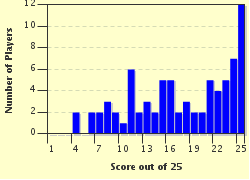Quiz Answer Key and Fun Facts
1. The Letter 'A'. According to the New King James Version Bible, what was the name of the king who reigned over the vast kingdom of Persia during the days of Esther?
2. The Letter 'B' is for 'Banquets'. According to Esther 5:4 what two guests did Esther invite to two banquets she hosted?
3. The Letter 'C' is for 'Concubines'. According to Scripture how many concubines did the king of the Persian empire have in his harem, in addition to Esther?
4. The Letter 'D' is for 'Decree'. What was the decree Haman was responsible for getting the king to approve? (Esther 3:5-15)
5. The Letter 'E' is for 'Enemies' of the Jews. According to Esther 9:1-17, what happened on the day the enemies of the Jews were to launch coordinated attacks?
6. The Letter 'F' is for 'Furious'. Why was Haman so furious with Mordecai that he decided to kill him and his people? (Esther 3:1-6)
7. The Letter 'G' is for 'God'. The book of Esther does not contain a single direct reference to God.
8. The Letter 'H' is for 'Haman'. According to Esther 3:1, what position did Haman have in the kingdom of Persia?
9. The Letter 'I' is for 'Intervene' and 'Intercessory'. Scripture states Esther decided to intervene to prevent Haman's diabolical plan from reaching fruition. In other words, she decided to go directly to the king to get a reversal of a decree ordering the extermination of the Jews. Why was this a risky move? (Esther 4:11-12)
10. The Letter 'J'. Which one of these words that start with the letter 'J' would best describe Mordecai's emotions after he was successful in thwarting plans by Haman?
11. The Letter 'K' is for 'Kibosh' and for 'Kill'. According to Scripture, Mordecai put a kibosh on a bid to kill the king. What are the names of the two palace doorkeepers who planned to kill the king? (Esther 2:19-23)
12. The Letter 'L' is for 'Lute' and for 'Lyre'. According to Esther 11:15, Esther was a talented musician who was skillful at playing the lute and the lyre.
13. The Letter 'M' is for 'Mordecai', who teamed up with Queen Esther to save the Jews from mass genocide. As per Esther 2:7, Esther and Mordecai were related. What was his relationship to Esther?
14. The Letter 'N' is for 'Numbered'. The days were numbered for the enemies of the Jews in the Persian empire after Haman launched a scheme for mass genocide. According to Esther 9:16, what's the number of the enemies of the Jews who were killed in Persia?
15. The Letter 'O' is for 'Orphan'. According to Scripture, Esther was an orphan. What was her original name, as per Esther 2:7?
16. The Letter 'P'. The annual Jewish holiday 'Purim' celebrates the accomplishments of Esther and Mordecai.
17. The Letter 'Q' is for 'Quiet'. Mordecai's good deed for the king was supposedly kept quiet with the king finding out by mishap one night. What was the good deed that was kept quiet? (Esther 2:19-23)
18. The Letter 'R' is for 'Royal Rules'. Esther 5:2 tells of Esther approaching the king without permission and the king extending his golden sceptre. What does the extension of the golden sceptre signify?
19. The Letter 'S'. According to Esther 1:2 in the NKJV, what was the name of the city where the king of Persia reigned?
20. The Letter 'T'. How many sons did Haman have, as per Esther 9:7-10?
21. The Letter 'U' is for 'Uzziah'. According to Esther 4:46, she gave birth to a son who was called Uzziah.
22. The Letter 'V' is for 'Vashti'. Esther was made queen after Vashti was deposed of the title by the king. Why was Vashti deposed? (Esther 1:11-13)
23. The Letter 'W' is for 'Work'. According to Esther 2:19 and 21, what type of work did Mordecai do in the palace of the king of Persia?
24. The Letter 'X' and 'Y'. According to the New International Version Bible, what was the name of the king who reigned over the vast kingdom of Persia during the days of Esther?
25. The Letter 'Z'. What was the name of Haman's wife, according to Esther 5:10?
Source: Author
Cowrofl
This quiz was reviewed by FunTrivia editor
LeoDaVinci before going online.
Any errors found in FunTrivia content are routinely corrected through our feedback system.

